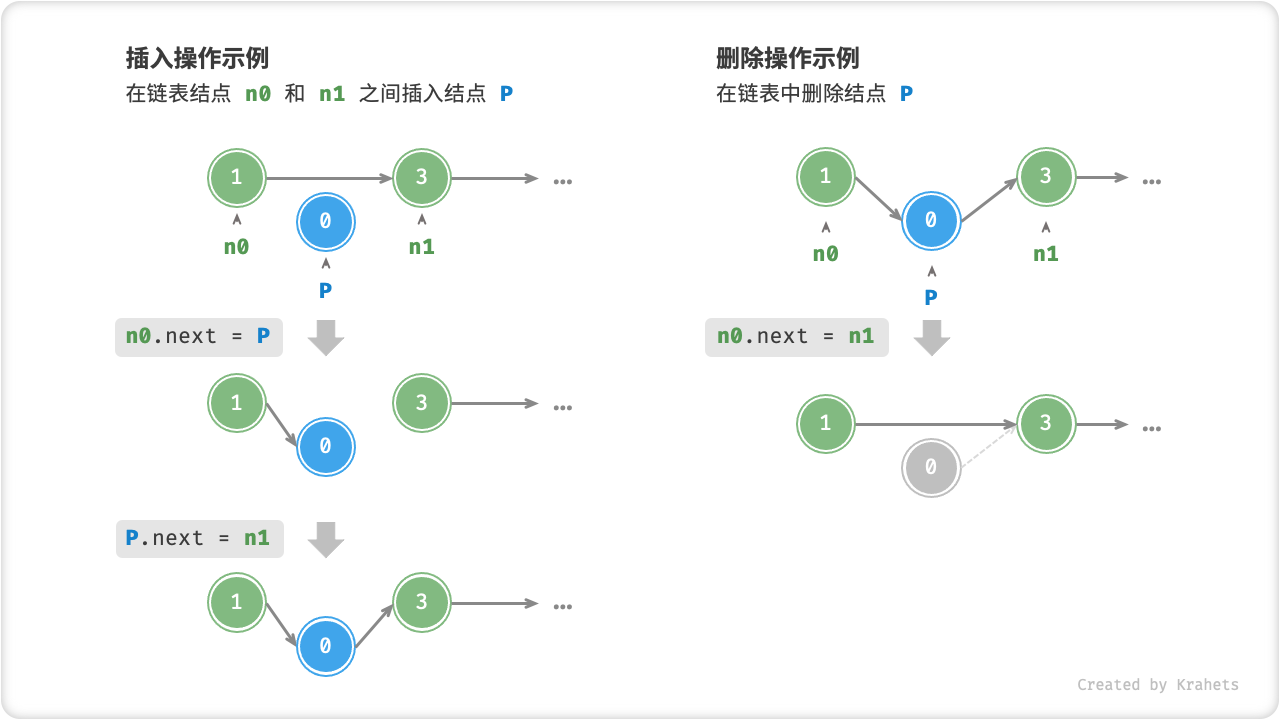链表¶
引言
内存空间是所有程序的公共资源,排除已占用的内存,空闲内存往往是散落在内存各处的。我们知道,存储数组需要内存空间连续,当我们需要申请一个很大的数组时,系统不一定存在这么大的连续内存空间。而链表则更加灵活,不需要内存是连续的,只要剩余内存空间大小够用即可。
「链表 Linked List」是一种线性数据结构,其中每个元素都是单独的对象,各个元素(一般称为结点)之间通过指针连接。由于结点中记录了连接关系,因此链表的存储方式相比于数组更加灵活,系统不必保证内存地址的连续性。
链表的「结点 Node」包含两项数据,一是结点「值 Value」,二是指向下一结点的「指针 Pointer」(或称「引用 Reference」)。

Fig. 链表定义与存储方式
尾结点指向什么? 我们一般将链表的最后一个结点称为「尾结点」,其指向的是「空」,在 Java / C++ / Python 中分别记为 null / nullptr / None 。在不引起歧义下,本书都使用 null 来表示空。
链表初始化方法。 建立链表分为两步,第一步是初始化各个结点对象,第二步是构建引用指向关系。完成后,即可以从链表的首个结点(即头结点)出发,访问其余所有的结点。
Tip
我们通常将头结点当作链表的代称,例如头结点 head 和链表 head 实际上是同义的。
链表优点¶
在链表中,插入与删除结点的操作效率高。 例如,如果想在链表中间的两个结点 A , B 之间插入一个新结点 P ,我们只需要改变两个结点指针即可,时间复杂度为 \(O(1)\) ,相比数组的插入操作高效很多。在链表中删除某个结点也很方便,只需要改变一个结点指针即可。

Fig. 在链表中插入与删除结点
链表缺点¶
链表访问结点效率低。 上节提到,数组可以在 \(O(1)\) 时间下访问任意元素,但链表无法直接访问任意结点。这是因为计算机需要从头结点出发,一个一个地向后遍历到目标结点。例如,倘若想要访问链表索引为 index (即第 index + 1 个)的结点,那么需要 index 次访问操作。
链表的内存占用多。 链表以结点为单位,每个结点除了保存值外,还需额外保存指针(引用)。这意味着同样数据量下,链表比数组需要占用更多内存空间。
链表常用操作¶
遍历链表查找。 遍历链表,查找链表内值为 target 的结点,输出结点在链表中的索引。
常见链表类型¶
单向链表。 即上述介绍的普通链表。单向链表的结点有「值」和指向下一结点的「指针(引用)」两项数据。我们将首个结点称为头结点,尾结点指向 null 。
环形链表。 如果我们令单向链表的尾结点指向头结点(即首尾相接),则得到一个环形链表。在环形链表中,我们可以将任意结点看作是头结点。
双向链表。 单向链表仅记录了一个方向的指针(引用),在双向链表的结点定义中,同时有指向下一结点(后继结点)和上一结点(前驱结点)的「指针(引用)」。双向链表相对于单向链表更加灵活,即可以朝两个方向遍历链表,但也需要占用更多的内存空间。
/* 双向链表结点类 */
class ListNode {
val: number;
next: ListNode | null;
prev: ListNode | null;
constructor(val?: number, next?: ListNode | null, prev?: ListNode | null) {
this.val = val === undefined ? 0 : val; // 结点值
this.next = next === undefined ? null : next; // 指向后继结点的引用
this.prev = prev === undefined ? null : prev; // 指向前驱结点的引用
}
}

Fig. 常见链表类型